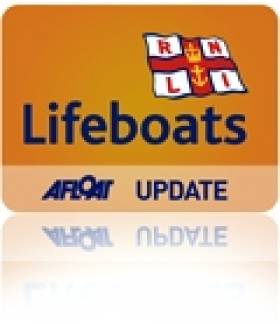Displaying items by tag: Rory Gallagher
#rnli – Dónal Gallagher, brother of the late blues guitarist Rory Gallagher has presented Ballycotton RNLI with a generous donation of €11,000 to help them continue their work of saving lives at sea.
This phenomenal donation was raised through the sale of items from the well- known and much loved guitarist, Rory Gallagher, at the Rock Memorabilia auction held recently at Whytes Auction House, which raised €7,500 for Ballycotton lifeboat station. A further donation of €3,500 was given from an anonymous unsuccessful bidder who wished to support the work of the life-saving charity.
'Rory was very fond of Ballycotton, he loved walking the cliffs and found inspiration for his song writing there - songs such as 'A Million Miles Away' and 'Lost at Sea', said the musician's brother, Donal Gallagher.
The Gallagher Estate gifted the Rory instruments to the RNLI at the Ballycotton RNLI's annual fundraising Gala dinner at Ballymaloe House, last January and auctioneer Ian Whyte offered his services (commission free), to fundraise for this great cause.
The RNLI is the charity that saves lives at sea and operates all over Ireland and the UK. Volunteer lifeboat crews provide lifesaving cover around the coast 365 days a year. On average it takes €1,502 to train a crew member annually and €1,343 for their lifesaving kit.
Ballycotton RNLI will be holding their annual Family Fun day during this Bank Holiday weekend on Sunday 3 August. This is one of their main fundraising activities for the year but also a great day out for everyone. Like their Facebook page 'Ballycotton Lifeboat Fundraising Events' for more details and watch the 'Lost at Sea'
#RNLI - The family of late musician Rory Gallagher have generously donated a replica Fender Stratocaster guitar, along with his original Oberheimer warm-up amplifier and stencilled flight case, to raise funds for Ballycotton RNLI.
The items will be auctioned later this month in aid of the Cork lifeboat station, whose lifeboat crew save lives at sea all year round.
The California-made Oberheim studio amp (serial 003), which was purchased by the guitarist in the mid 1970s, is extremely rare and remains in good working order.
These items will be offered for bidding as part of Whyte's Pop & Rock Memorabilia auction on Saturday 31 May from 4pm-6pm.
Viewing will be at Whyte’s galleries in Molesworth Street on Thursday 29 and Friday 30 May from 10am-5pm and Saturday 31 May from 9am-noon. Whyte’s have generously agreed to waive their commission so that all proceeds will go to the RNLI.
Dónal Gallagher, brother of the late blues-rock musician, said: "Rory would visit Ballycotton, where he was inspired to write material. This part of the country was very special to him and our family is delighted to be able to do this for Ballycotton RNLI.
"The volunteer lifeboat crew based there launches their lifeboat in all weathers and to all types of emergencies, saving lives at sea and helping those in trouble.
"I hope people who have a love of Rory’s music and are interested in the auction will take pleasure in knowing that in purchasing this incredible guitar and Rory’s own amp and flight case, that they are helping a great charity."
Speaking on Gallagher family’s kind donation to the charity, chair of the Ballycotton RNLI fundraising branch, Fiona Flynn, said: "We are extremely honoured by the Gallagher family’s kind donation... Rory Gallagher is one of the most respected and talented musicians ever to come out of Ireland and we are delighted that his family have chosen Ballycotton lifeboat station to benefit from this special auction."
Last year Ballycotton RNLI lifeboat launched 28 times and rescued 10 people. The majority of lifeboat crews are volunteers who undergo rigorous training to deal with every type of emergency at sea.






























































